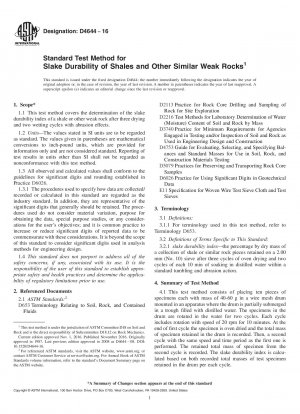ASTM D4644-16
Standard Test Method for Slake Durability of Shales and Other Similar Weak Rocks
- Standard No.
- ASTM D4644-16
- Release Date
- 2016
- Published By
- American Society for Testing and Materials (ASTM)
- Latest
- ASTM D4644-16
- Scope
5.1 The test method is used to estimate qualitatively the durability of weak rocks through weakening and disintegration resulting from a standard two cycles of wetting and drying in the service environment. (1-7).3
5.2 This test method is used to assign quantitative durability index values to weak rocks. A primary example is the Franklin Rating System (1).
Note 1: The quality of the result produced by this standard is dependent on the competence of the personnel performing it, and the suitability of the equipment and facilities used. Agencies that meet the criteria of Practice D3740 are generally considered capable of competent and objective testing, sampling, inspection, and so forth. Users of this standard are cautioned that compliance with Practice D3740 does not in itself assure reliable results. Reliable results depend on many factors; Practice D3740 provides a means of evaluating some of those factors.
1.1 This test method covers the determination of the slake durability index of a shale or other weak rock after three drying and two wetting cycles with abrasion effects.
1.2 Units—The values stated in SI units are to be regarded as standard. The values given in parentheses are mathematical conversions to inch-pound units, which are provided for information only and are not considered standard. Reporting of test results in units other than SI shall not be regarded as nonconformance with this test method.
1.3 All observed and calculated values shall conform to the guidelines for significant digits and rounding established in Practice D6026.
1.3.1 The procedures used to specify how data are collected/recorded or calculated in this standard are regarded as the industry standard. In addition, they are representative of the significant digits that generally should be retained. The procedures used do not consider material variation, purpose for obtaining the data, special purpose studies, or any considerations for the user’s objectives; and it is common practice to increase or reduce significant digits of reported data to be commensurate with these considerations. It is beyond the scope of this standard to consider significant digits used in analysis methods for engineering design.
1.4 This standard does not purport to address all of the safety concerns, if any, associated with its use. It is the responsibility of the user of this standard to establish appropriate safety ......
ASTM D4644-16 Referenced Document
- ASTM D2113 Standard Practice for Rock Core Drilling and Sampling of Rock for Site Investigation
- ASTM D2216 Standard Test Method for Laboratory Determination of Water (Moisture) Content of Soil and Rock by Mass
- ASTM D3740 Standard Practice for Minimum Requirements for Agencies Engaged in the Testing and/or Inspection of Soil and Rock as Used in Engineering Design and Construction
- ASTM D4753 Standard Specification for Evaluating, Selecting, and Specifying Balances and Scales for Use in Soil, Rock, and Construction Materials Testing
- ASTM D5079 Standard Practices for Preserving and Transporting Rock Core Samples
- ASTM D6026 Standard Practice for Using Significant Digits in Geotechnical Data
- ASTM D653 Standard Terminology Relating to Soil, Rock, and Contained Fluids
- ASTM E11 Standard Specification for Wire Cloth and Sieves for Testing Purposes
ASTM D4644-16 history
- 2016 ASTM D4644-16 Standard Test Method for Slake Durability of Shales and Other Similar Weak Rocks
- 2008 ASTM D4644-08 Standard Test Method for Slake Durability of Shales and Similar Weak Rocks
- 2004 ASTM D4644-04 Standard Test Method for Slake Durability of Shales and Similar Weak Rocks
- 1987 ASTM D4644-87(1998) Standard Test Method for Slake Durability of Shales and Similar Weak Rocks

Copyright ©2024 All Rights Reserved